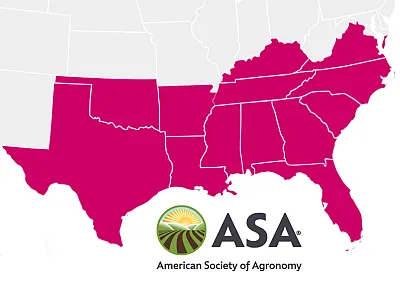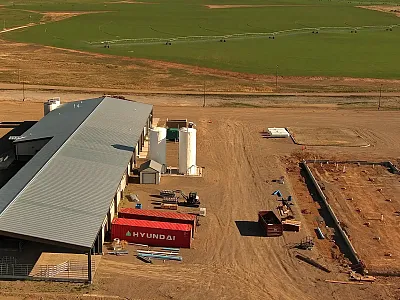Sweet corn productivity under strategic irrigation and biochar application in the Texas Southern High Plains
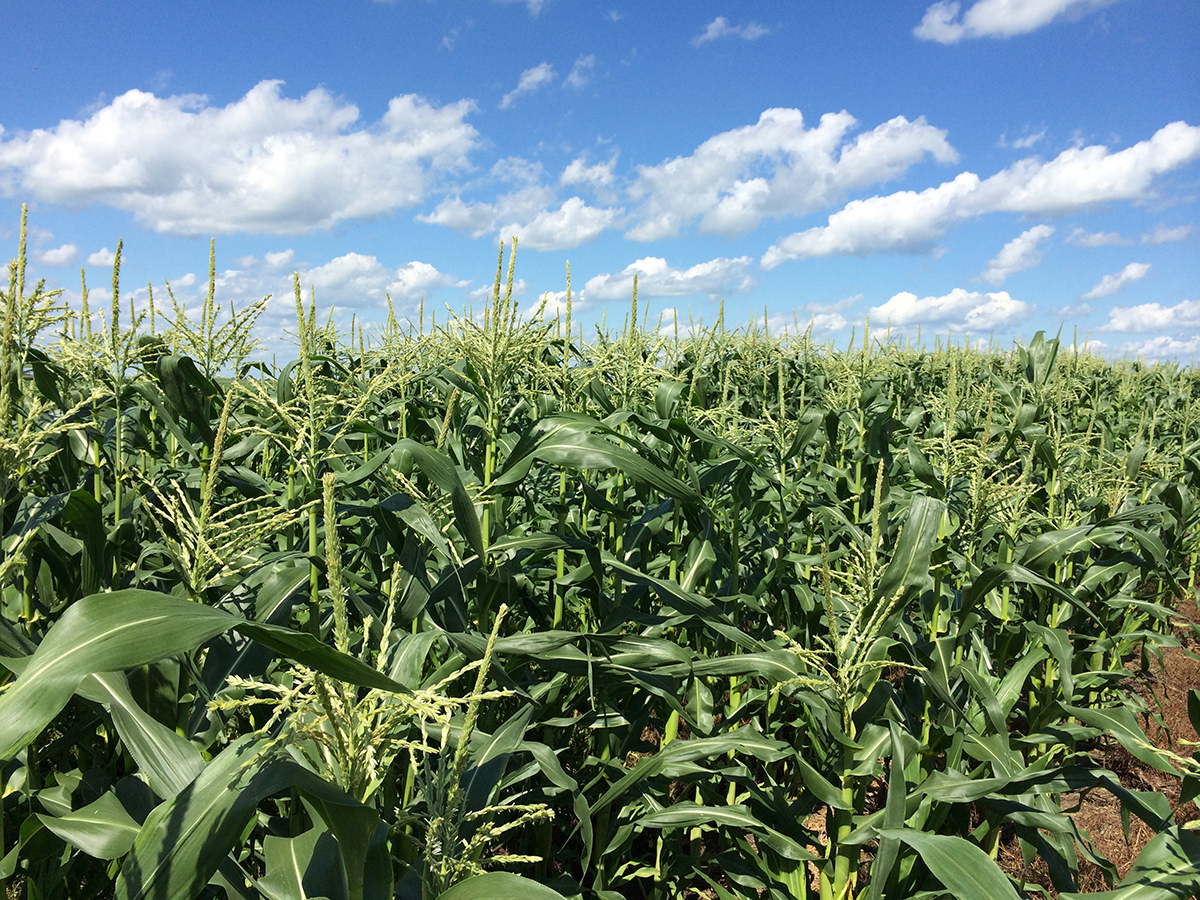

The Texas Southern High Plains faces severe water limitations for agriculture, making efficient irrigation essential due to high evapotranspiration and declining groundwater from the Ogallala Aquifer. To address this, researchers developed a growth stage-based irrigation strategy for sweet corn, paired with biochar soil amendments, aiming to improve water productivity under drought-prone conditions. A two-year field study tested different irrigation levels and biochar rates to evaluate their effects on sweet corn growth, yield, and water efficiency. Earn 0.5 CEUs in Soil & Water Management by taking the quiz for the article.
The Texas Southern High Plains (TSHP) is located in a semi-arid climatic region where water is a limiting factor for crop production. With average annual evapotranspiration exceeding average annual rainfall by three times, irrigation is essential for sustaining agricultural production. Figure 1 illustrates the water deficit in the soil during the corn growing season (April–August), highlighting the need for irrigation in the West Texas region of the TSHP.

The Ogallala Aquifer, the primary underground water resource that supplies 90% of the region's irrigation needs, is depleting due to a withdrawal rate that exceeds its recharge (McGuire, 2017). With an increasing risk of potential drought episodes in the future, vegetable growers are finding it more challenging to maintain a profitable farm in the long run. As the population in West Texas continues to grow, the demand for locally grown fresh vegetables is rapidly increasing. This trend offers vegetable growers hope for sustaining their businesses, provided they can identify suitable crops that thrive in limited water conditions. Sweet corn has the potential to flourish under harsh conditions and holds significant economic importance for Texas and its culinary traditions. With funding support from the Texas Department of Agriculture Specialty Crop Grant, we developed a strategy that combines irrigation and biochar as a soil amendment to optimize sweet corn yield in West Texas region of the TSHP.
Corn doesn’t need same amount of water to be applied throughout its growing season as its sensitivity towards water stress varies depending upon its growth stages. We were more interested in enhancing water productivity, i.e., yield per drop of water rather than just yield. By reviewing the scientific literature, we developed a growth stage-based irrigation strategy to water-stress sweet corn to a degree that can sustain yield but save huge amounts of water in irrigation. Corn in general is more tolerant to water stress during its vegetative stage than its reproductive stage. Water deficit conditions during and after tasseling in corn induce flower abortion, poor grain filling, and ultimately yield. While some other research suggests otherwise, we believe that greater water availability during the vegetative stage will help corn to attain greater leaf area and photosynthates that will prepare it for greater water stress in later growth periods (Geerts & Raes, 2009; Harb et al., 2010). Most research is concentrated only on grain corn with very limited information on vegetable sweet corn in the literature, demanding better understanding of vegetable corn under water deficit conditions.
We need to find drought-adaptive agricultural practices that can complement irrigation in mitigating water stress in crops, and one potential way could be biochar application, but research is needed to justify it in this region. Biochar, occasionally referred as a “black gold” in agriculture, is a porous, carbonaceous compound that is widely used as a soil amendment for its ability to mitigate water stress in crops by holding more water in soil. Looking at its widespread application, mostly in water-scarce regions, we came up with an idea of integrating irrigation with biochar to see their interactive effects on sweet corn productivity. Although no recommendations for biochar rate has been specified in the West Texas region for agricultural production purposes, we decided to go with similar rates applied in similar agroclimatic conditions in the United States. From our past research work in biochar, we knew different biochar types didn’t have much impact, but we wanted to determine whether different rates can enhance water productivity of sweet corn. The objective of our study was to evaluate the effect of varying irrigation regimes and biochar rates on sweet corn growth, physiology, yield and water productivity.
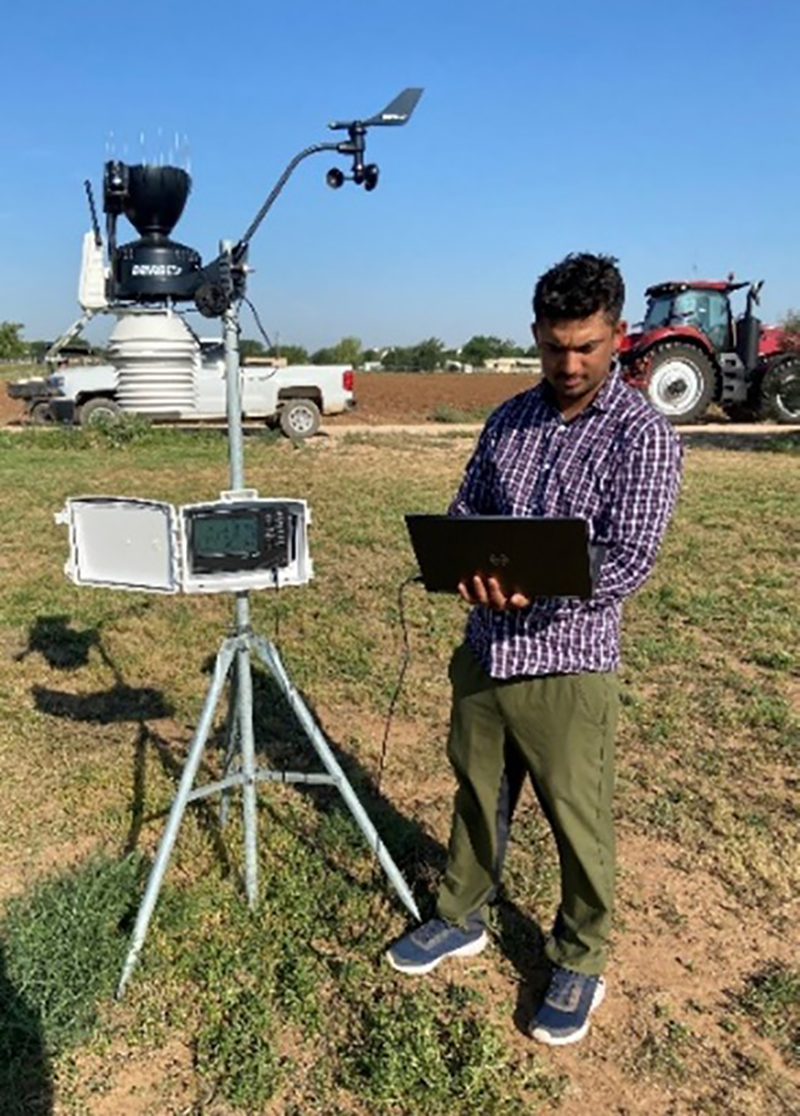
How was it done?
A two-year (2021–2022) research trial was conducted at Quaker Research Farm of Texas Tech University. The soil type is relatively sandy (55%) with 33% clay content arising from a mixture of Amarillo sandy clay loam and Olton clay loam. Weather parameters were acquired from a weather station installed near the trial location from which reference evapotranspiration (ETo) was calculated using Penman–Monteith equation, which was later multiplied with a crop coefficient (Kc) to calculate crop evapotranspiration (ETc) (Figure 2).
An experimental design was laid out comparing four different irrigation methods targeted to meet the crop water demand (ETc). Irrigation that met 100% ETc was considered full irrigation, 80% ETc was mild-stress irrigation, 60% ETc was moderate-stress irrigation, and 40% ETc was severe water-stress irrigation. The treatments included:
I1 receiving full irrigation,
I2 receiving mild irrigation before tasseling (50–55 days after planting) followed by moderate-stress irrigation after tasseling until harvest,
I3 receiving moderate irrigation before tasseling followed by mild-stress irrigation after tasseling until harvest, and
I4 receiving severe water stress irrigation only (Figure 3).
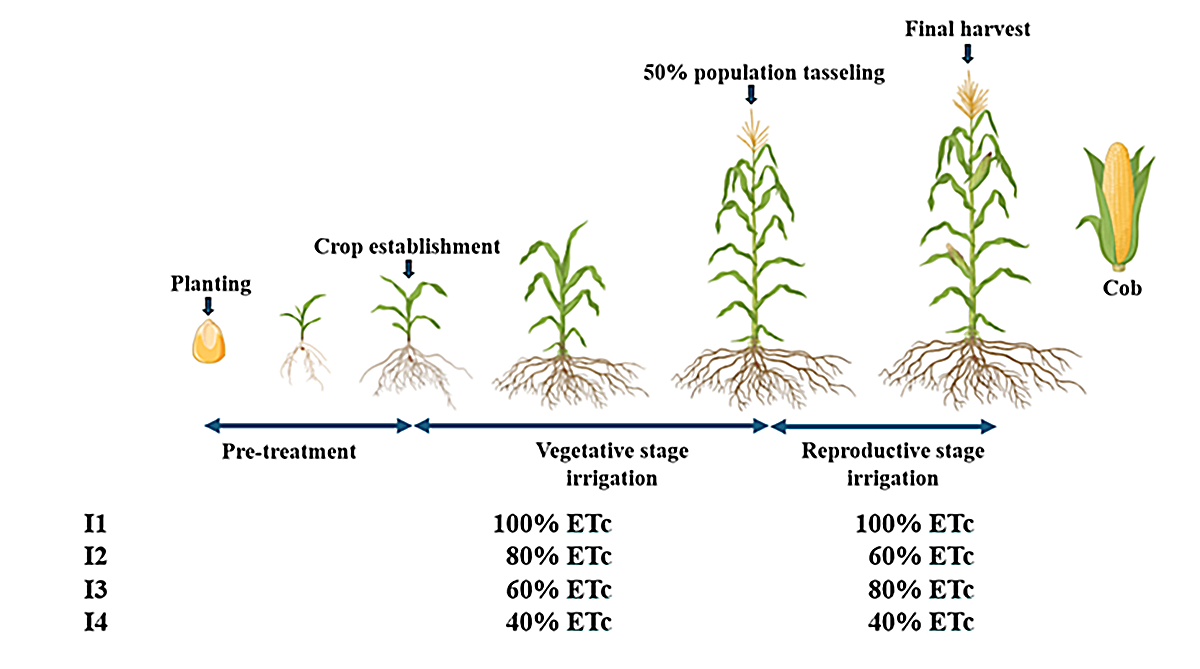
Hardwood biochar made from oak tree feedstock was applied once in the first year and incorporated into a 0- to 6-inch soil depth, and its effect on sweet corn performance was observed for two immediate years (Figure 4).

Three biochar treatments of 0 tons/ac (i.e., no biochar), 6.7 tons/ac, and 8.9 tons/ac were tested in the same plots for two years. Sweet corn response to irrigation regimes and biochar rates were observed in growth, physiology, yield, and water productivity (Figure 5).

What do the results tell us?
Comparing 2021 and 2022 growing seasons, the latter experienced prolonged heat and dry spells with minimal rainfall. These conditions exposed plants to greater stress in 2022. The total precipitation received in 2021 was 10 inches while it was just 4.8 inches in 2022. The unfavorable weather conditions in 2022 required greater need of irrigation water (Table 1).
Irrigation and water savings | Irrigation treatmenta | ||||||||
2021 |
| 2022 | |||||||
I1 | I2 | I3 | I4 | I1 | I2 | I3 | I4 | ||
Total irrigation (inches) | 11.8 | 8.8 | 8.8 | 7.1 |
|
|
|
|
|
Irrigation savings (%) |
| 25 | 25 | 40 |
| 21 | 22 | 60 | |
a I1, receiving full irrigation; I2, receiving mild irrigation before tasseling (50–55 days after planting) followed by moderate-stress irrigation after tasseling until harvest; I3, receiving moderate irrigation before tasseling followed by mild-stress irrigation after tasseling until harvest; I4, receiving severe water stress irrigation only.
| |||||||||
Plant height is a vegetative progress that plants strive to acquire until plant transition into the reproductive stage. This experiment demonstrated that sweet corn has the potential to tolerate moderate water stress during the vegetative stage without compromising plant height. Specifically, irrigation level I3 maintained a similar height to I1 and I2 while a rapid decline in height was observed under I4 during the active vegetative stage. Leaf water potential, a measure for leaf water status, under I4 had more negative value, suggesting leaf water demand is very high for proper cellular functioning. Leaf area index, which reflects the area for stomata for photosynthesis, also declined when water limitation becomes extreme. Interestingly, irrigation level I3 not only maintained plant height but also exhibited a similar leaf expansion potential, despite the imposition of moderate water stress during the active vegetative stage.
Chlorophyll content maintains the greenness of the plant. When a plant experiences water stress, the chlorophyll pigments in the leaf start to disrupt, and plants start to lose their photosynthesizing ability. Results showed that, under full irrigation, plants retain their chlorophyll pigments, but as the water limitation progresses, chlorophyll gets affected and declines considerably.
Other physiological changes also occur at the leaf level. Stomatal conductance is a process that regulates the carbon dioxide intake for photosynthesis. This study showed that when water gets scarce in plants, they intend to close stomata to prevent loss of water through transpiration. This suggests that stomatal conductance remained lowest at I4 and highest in I1, reflecting the plant water status. This directly affects the photosynthesis process in plants as a reduction in stomatal conductance compromises the pathways for carbon dioxide intake.
Partitioning the whole plant into leaf, stem, and tassel biomass showed the resource allocation to individual parts under varying water stress levels. As expected, the larger leaf and stem acquired under full irrigation increased the overall vegetative biomass under I1 followed by I3, I2, and I4. Cob yield (lb/acre) was found to be similar under I1 and I3 (Figure 6). This implies that if water scarcity is a major concern for crop production, applying moderate water stress during the vegetative stage while ensuring a mild stress level during the reproductive stage can result in comparable or even higher yields than full irrigation. Across two years, yield decreased by 29 and 50% under I2 and I4, respectively.
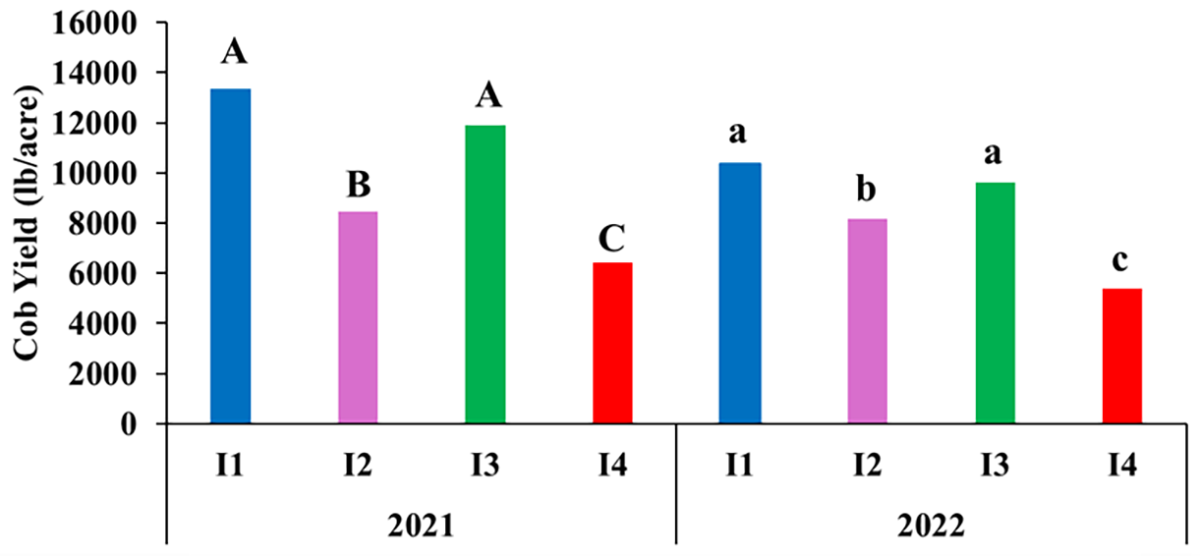
This explains the crop’s adaptability to water stress during the vegetative stage and its sensitivity during the reproductive stage. I3 also proved to be the most water productive irrigation strategy (more yield per drop of water) in both years (Figure 7). This provides significant relief to sweet corn producers in semi-arid regions as it suggests that if the crop receives adequate water during its reproductive stage, moderate water stress during the vegetative stage may not significantly affect yield or water productivity.
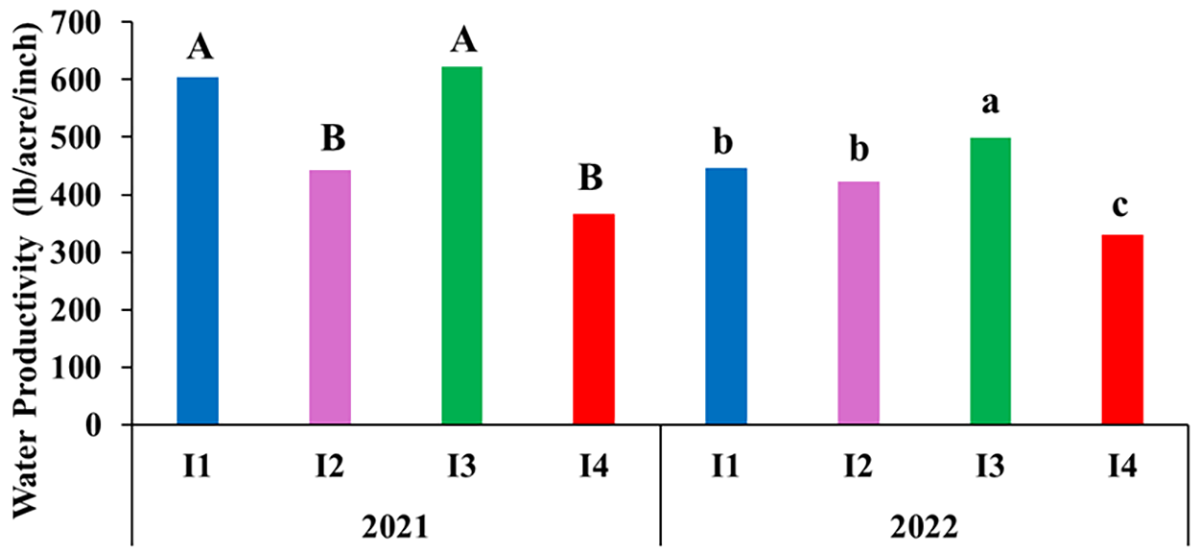
Although biochar had some positive effects on plant height and biomass, it had little to no impact on yield and water productivity. This suggests that freshly applied biochar may not significantly influence crop performance in semi-arid sandy clay loam soil.
Conclusions
This study concludes that the effects of irrigation are more prominent than the effects of biochar on sweet corn performance in West Texas. Irrigation I3, which targets moderate water stress during the vegetative stage of sweet corn followed by mild stress during the reproductive stage, will sustain growth, physiology, and yield, making it a more water-efficient strategy. There is a need for long-term studies to show the enhanced effects of biochar under varying irrigations on crop performance.
References
Geerts, S., & Raes, D. (2009). Deficit irrigation as an on-farm strategy to maximize crop water productivity in dry areas. Agricultural Water Management, 96(9), 1275–1284.
Harb, A., Krishnan, A., Ambavaram, M. M., & Pereira, A. (2010). Molecular and physiological analysis of drought stress in Arabidopsis reveals early responses leading to acclimation in plant growth. Plant Physiology, 154(3), 1254–1271.
McGuire, V. L. (2017). Water-level and recoverable water in storage changes, high plains aquifer, predevelopment to 2015 and 2013–15 (U.S. Geological Survey Scientific Investigations Report 2017–5040). https://doi.org/10.3133/sir20175040
Dig deeper
Kafle, A., Singh, S., Deb, S., Simpson, C., & Ritchie, G. (2025). Physiology, growth, and yield of sweet corn as affected by growth stage-based irrigation management and biochar application. Crop Science, 65, e70021. https://doi.org/10.1002/csc2.70021
Self-study CEU quiz
Earn 0.5 CEUs in Soi & Water Management by taking the quiz for the article. For your convenience, the quiz is printed below. The CEU can be purchased individually, or you can access as part of your Online Classroom Subscription.
What does ETc denote?
a. Reference evapotranspiration.
b. Crop evapotranspiration.
c. Crop coefficient.
d. Rainfall.
What is biochar occasionally referred to in agriculture?
a. White gold
b. Black gold
c. Brown gold
d. Golden gold
Which of the following was an accurate conclusion made about biochar in this study?
a. Its effects are more prominent than the effects of irrigation on sweet corn performance in West Texas.
b. It had little to no impact on plant height and biomass in West Texas.
c. It had little to no impact on yield and water productivity in West Texas.
d. Its effects are more prominent than the effects of nutrient or pest management.
Which irrigation treatment performed well overall in terms of water productivity?
a. I1 (full irrigation).
b. I2 (mild stress in vegetative and moderate stress in reproductive).
c. I3 (moderate stress in vegetative and mild stress in reproductive).
d. I4 (severe stress).
Which crop stage of sweet corn is more tolerant and sensitive towards water stress?
a. Vegetative is tolerant and reproductive is sensitive.
b. Vegetative is sensitive and reproductive is tolerant.
c. All the above.
d. None of the above.
Text © . The authors. CC BY-NC-ND 4.0. Except where otherwise noted, images are subject to copyright. Any reuse without express permission from the copyright owner is prohibited.




